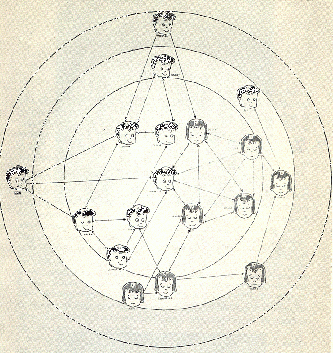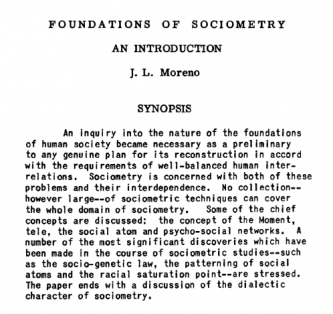User:Lidia.Pereira/GRS/SG
Sociogram
What is it?
The sociogram is a graphical representation of social relantionships in the terms of nodes and links, where every node represents a person and every link represents a relationship.
Merriam-Webster Dictionary:
History
In the late 1930's, Jacob Levy Moreno, psychologist and the founder of sociometry, accomplished quite a successful intervention at the New York State Training School for Girls Hudson, whose drop out rate was way above average. Diagnosing the problem as one embedded in the existing network of social relationships between the girls, he conducted a simple survey to help him "map the network" - thus creating a sociogram. By studying the girls answers (e.g.: "Who do you want to sit next to?") and juxtaposing them to the current dormitory arrangements, he was able to avoid conflicts by re-allocating them. This proved effective in diminishing the runaway rate. By re-engineering their social relationships, Moreno was able to create a better functioning, more productive network.
Social Engineering
"The aim of social engineering was to make society rational and train the state for maximum efficiency in the same way my father trained workers. He believed society could be controlled like a machine. The aim was to install these social engineering machines all over the USSR. These machines would make society function totally rationally. Man would become a rational component of the machine." Alexei Gastev Jr.
The oficial definition of the term social engineering describes it as "a discipline in social science that refers to efforts to influence popular attitudes and social behaviors as a large scale, whether by governments, media, or private groups."
In "Foundations of Sociometry", Jacob Levy Moreno aknowledges the importance of informational technologies over networks by observing the distorting effect of the printed page over human spontaneity. Such observation made Moreno realize the effects of the superimposition of a "mechanical-social network" upon a "psycho-social network" removes society from human control.
Being human spontaneity the core of social sciences, it is important for the construction and planning of human society, according to Moreno, to have full knowledge of the central infrastructure of human relationships. This is the fundamental aim of any given sociometric experiment. "The social scientist must, of necessity, acquaint himself, in the research phase, with the individuals themselves and the interrelations between them. Analysis and action, social research, and social construction,are interwoven.". This research is all the more accurate if every social atom participates. Participation entails better tracing of patterns, habits and relations, thus making social engineering all the more fine-tuned towards general productivity.
In "Open Society", Karl Popper distinguishes between Utopian Social Engineering and Piecemeal Social Engineering. Utopian Social Engineering dictates that all rational actions must be taken in light of a ultimate aim. Thus, this aim must be the first thing to be specified and only then can a plan be drawn. Politically speaking, this aim represents the Ideal State. Piecemeal Social Engineering, on the other hand, may or may not have an idea of the Ideal State, but takes such stage as distant. Thus, it aims to search and fight the immediate problems in society, avoiding unhappiness whenever possible, doing the possible to "improve the lot of men" instead of postponing action until more favourable conditions are reached. In Popper's opinion, this approach is the most methodogically reasonable.
It is interesting to note the utilitarian connection of social engineering to the Taylorist system, also known as the scientific organization of labor, whose purpose is one of improving economic efficiency by the application of positive scientific laws to the analysis and implementation of workflows. Taylorism enjoyed widespread acceptance in the early stages of the Soviet Union, namely by Vladimir Lenin and Leon Trotsky. Alexei Gastev, the founder of the Central Institute of Labour whose work most contributed to the spreading of taylorist ideals, believed that revolution could only be recognized as such if the workers were empowered to control the work processes. He trained workers to behave and think in a rational way, going so far as to build a social engineering machine, whose ways nobody, to this day, understands. (more to come - comparison of Gastev's ideals of rational society to those of Ayn Rand, influence of "The Fountainhead" and "Atlas Shrugged" over Sillicon Valey entrepeneurs)
Database Abstraction
"The larger-than-life personalities of fearless dissidents that melted the icy heart of the Stasi officer in The Lives of Others are barely visible to the Internet police, who see the subjects of surveillance reduced to one-dimensional, boring database entries." Evgeny Morozov, "The Net Delusion"
Graph API
Outline:
- Social Engineering as enforcing the positive science model (ideological extension of self-regulatory economy)
- The abstraction of the social graph + Facebook API
- The abstraction of the database and objectification of the designed subject ("The larger-than-life personalities of fearless dissidents that melted the icy heart of the Stasi officer in The Lives of Others are barely visible to the Internet police, who see the subjects of surveillance reduced to one-dimensional, boring database entries." The Net Delusion, Evgeny Morozov)
READ/WATCH/RESEARCH:
"Pandora’s Box: The Engineers Plot", Adam Curtis
"All Watched Over by Machines of Loving Grace", Adam Curtis
"Provocative Containment and the Drift of Social-Scientific Realism", Signe Vikkelsø
"Foundations of Sociometry: An Introduction in Sociometry", J.L. Moreno
Otto Neurath and the Isotype (Keynesianism, state capitalism, social democracy, welfare state)
Nicholas Rose
Behaviorism



